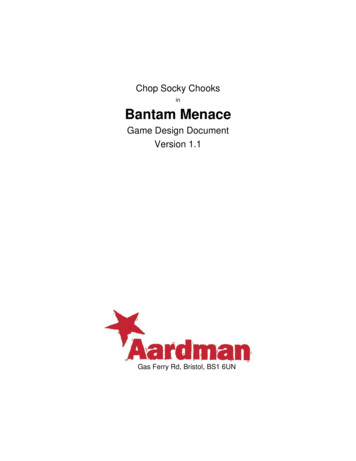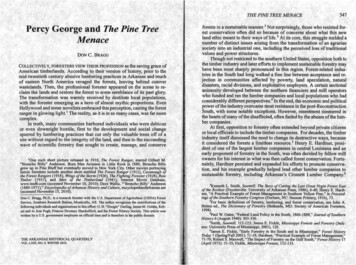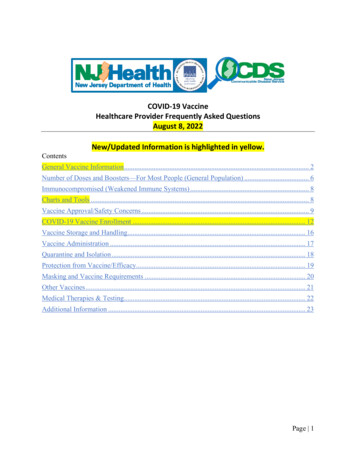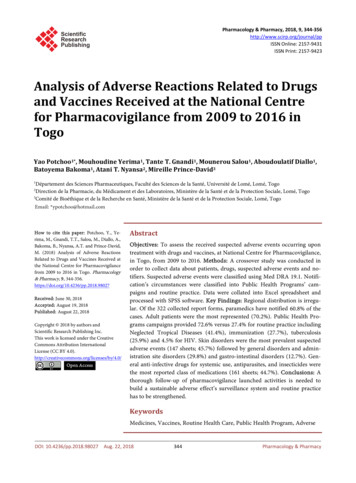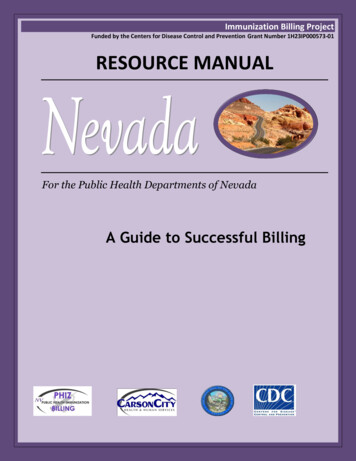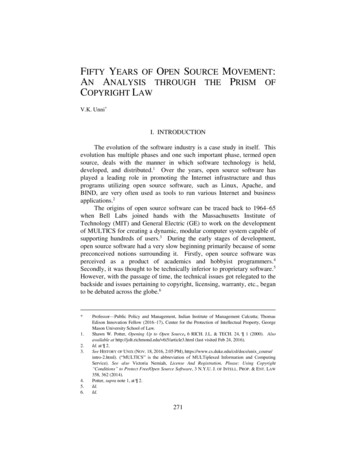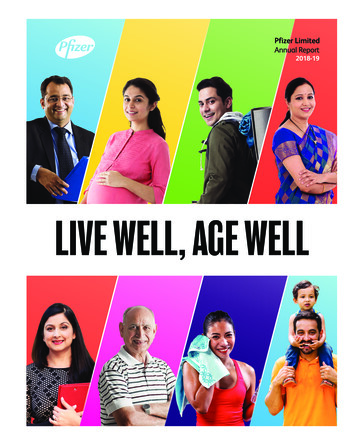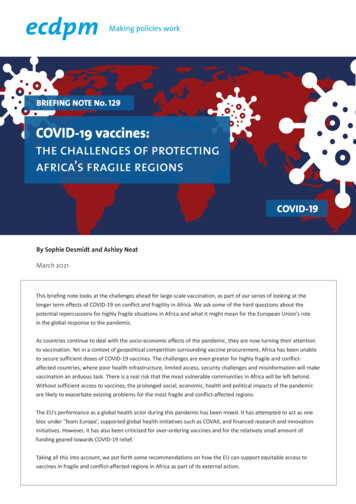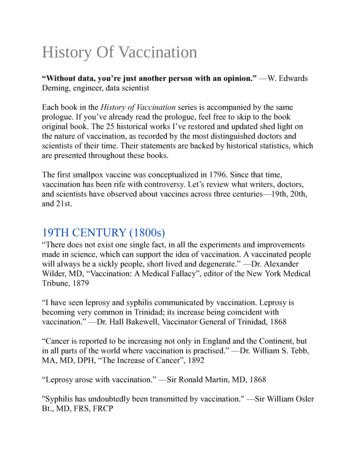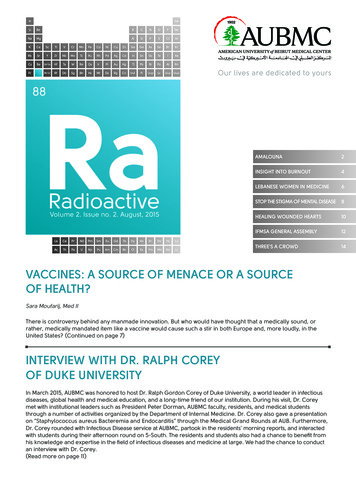
Transcription
AMALOUNA 2Volume 2. Issue no. 2. August, 2015INSIGHT INTO BURNOUT4LEBANESE WOMEN IN MEDICINE6STOP THE STIGMA OF MENTAL DISEASE8HEALING WOUNDED HEARTS10IFMSA GENERAL ASSEMBLY12THREE’S A CROWD14VACCINES: A SOURCE OF MENACE OR A SOURCEOF HEALTH?Sara Moufarij, Med IIThere is controversy behind any manmade innovation. But who would have thought that a medically sound, orrather, medically mandated item like a vaccine would cause such a stir in both Europe and, more loudly, in theUnited States? (Continued on page 7)INTERVIEW WITH DR. RALPH COREYOF DUKE UNIVERSITYIn March 2015, AUBMC was honored to host Dr. Ralph Gordon Corey of Duke University, a world leader in infectiousdiseases, global health and medical education, and a long-time friend of our institution. During his visit, Dr. Coreymet with institutional leaders such as President Peter Dorman, AUBMC faculty, residents, and medical studentsthrough a number of activities organized by the Department of Internal Medicine. Dr. Corey also gave a presentationon “Staphylococcus aureus Bacteremia and Endocarditis” through the Medical Grand Rounds at AUB. Furthermore,Dr. Corey rounded with Infectious Disease service at AUBMC, partook in the residents’ morning reports, and interactedwith students during their afternoon round on 5-South. The residents and students also had a chance to benefit fromhis knowledge and expertise in the field of infectious diseases and medicine at large. We had the chance to conductan interview with Dr. Corey.(Read more on page 11)
OUT LOUDHow does AMALOUNA help raise publicawareness on cancer?AMALOUNA ( )أملنا : “WHEN THERE ISRESEARCH, THERE IS HOPE.”Zaynab Jaber, MSc & Farah J. Nassar, PhD candidateCancer research has become one of the largest and most rapidly developing areasin the biomedical sciences. Investment in cancer research during the last decadeshas made significant contributions to help cure the disease that has plaguedhumanity for thousands of years. These discoveries have led to improvementsin cancer prevention, diagnosis, treatment, and patients’ survival rates. Forinstance, the five-year survival rates for all types of childhood leukemia rosefrom 48% to 83% between 1975 and 2010 (American Cancer Society).Knowledge is power, andAMALOUNA aims to empowerthe public and specificallythe new generation with theprecise knowledge ofcancer, cancer research,its importance, as wellas its obstacles.Dr. Rihab Nasr, Associate ProfessorAlthough cancer researchers in Lebanon have the knowledge and skills requiredto significantly contribute to cancer research, they face a major challenge: thelack of adequate resources. The Lebanese government, supported by severaluniversities, dedicates minimal funds to this much needed research. Externalfunding also remains difficult to obtain since Lebanon is not always consideredwithin the zone of countries that qualify for financial aid (World BankClassification). Additionally, many members of our Lebanese community lacka clear understanding of what causes cancer, its prevention or treatment, andhow researchers develop evidence-based cures. Moreover, another obstaclefaced by research is the lack of awareness of both school-age students and thecommunity at large who do not acknowledge research as a career path as theyare unaware of its potential as a job in Lebanon.The importance of raising nationwide awareness about cancer research led to theestablishment of AMALOUNA ( )أملنا , an American University of Beirut-affiliatededucational organization that promotes research as humanity’s best defenseagainst cancer and highlights the importance of investing in scientific research toexplain and understand cancer at the molecular and biological level. AMALOUNAwas pioneered by Dr. Rihab Nasr, an associate professor in the Department ofAnatomy, Cell Biology, and Physiology, Faculty of Medicine at AUB in March2014. Her vision is gaining traction both on and off AUB campus. Currently, theorganization not only includes AUB students (undergraduates, Masters, PhDs)of different majors and backgrounds, but also people of diverse vocations.To date, AMALOUNA has successfully participated in the Women’s Race organizedin May 2014 and in the Beirut Marathon 2014. Additionally, a series of cancerresearch awareness lectures have been launched for high school students andthe community. AMALOUNA also encouraged young researchers to commit tothe cause by awarding 500 prize to the most outstanding cancer research poster atAUB’s Biomedical Research that took place in February 2015. As long-term goals,AMALOUNA aims to organize fundraising events to support cancer research inLebanon and launch a program that promotes science and research in secondaryschools by exposing students to the research community at an early stage.With research, a cure forcancer is possible! Byencouraging youth to pursueresearch and raising nationalawareness of scientificendeavors in this field, wecan be a stronger forceagainst the disease. That iswhy I joined AMALOUNA!Zeina Azrak, MSc2
Being part of AMALOUNA makes us aspire for a healthier future with the help of a community that embraces andappreciates cancer research. We would not be on our current path of revolutionizing cancer therapy if not for theextraordinary endeavors of individuals working in numerous research disciplines and technologies. We hope that oneday, cancer research will become a national priority.Follow us on Facebook: www.facebook.com/AmalounaAUB and look us up on kickstarter.com to see how you can bemore involved in our cause.WHY DOES RESEARCH IN LEBANON YIELD LESSPUBLICATIONS THAN RESEARCH ABROAD?Patrick Aouad, MSc candidate & Zaynab Jaber, MScIt is undeniable that research in Lebanon has been advancing over the last few years, contributing to significantimprovements in the fields of science and industry. Unfortunately, this is where the story ends. If we were toevaluate where major breakthroughs and discoveries take place, it shouldn’t come as a surprise that big thingsapparently happen abroad.Ultimately, for research to be of value, it needs to be made available to all, including the public, through publication. In fact,publishing figures are often used as a measure of productivity and a criterion for career advancement. The tendency forLebanese scientists to publish in mainstream journals has been increasing (around 450 per year) according to internationaldatabase indexes such as SCI and PASCAL. However, most of scientific writings remain locally or regionally publishedmaking them less visible and less likely to be picked up by the media and the general public.Lebanon’s current average of publication output is similar to that of Iran and Morocco in the mid-1990s and that of Tunisiaand Algeria just a few years back (ESTIME 2007). Lebanon was lagging behind Jordan in the late 1980s and early 1990sbut regained the lead in 2004. Iran currently produces more than 4,000 publications a year and has become a majorscientific power in the region (SCI). The trend among countries in the region shows that increased political and financialsupport allows for competition and advancement in the scientific sector and builds wealth and economic developmentfor these particular countries, allowing for continued support to research and development.Without surprise, the top producer (52% of the number of publications) and the renowned of the Lebanese institutionsis AUB. Being the oldest university in Lebanon, AUB has always championed the idea that good teaching and advancedresearch go hand in hand. AUB has the highest research budget in Lebanon and the best-organized institutionalmechanisms to assist the AUB community with research projects sponsored through various funding sources. AUBencourages newly appointed faculty members to join its research fields, providing them with spacious labs and theopportunity to seed research grants. What distinguishes AUB from other universities is the coadunation of a “publish orperish” culture that promotes high expectations for publication quantity and quality in order for a faculty member toseek promotion.Lebanon should continue to increase the rate of growth in its publication by strengthening its mobilization and betterstructuring its research potential as well as by sustaining and renewing its national policy buttressed by adequatefinancial support. Unfortunately, figures from the World Bank and the National Council for Scientific Research showthat Lebanon spends 0.2% of its GDP on scientific research. This lack of financial support is a major setback whichprevents our progress towards establishing labs and state-of-the-art resources to conduct research and generatehigh throughput data.Consequently, Lebanese researchers are often faced with the challenge of funding potential projects, which is whythey spend most of their time writing grants—a time and effort-demanding task that can extend up to months. Moreover, even an item ordered online takes on average 3 to 6 weeks to arrive to Lebanon and can be quite expensive dueto the shipment costs. In the United States, scientists expect the arrival of the same item within days. This indeed has atremendous impact on the continuity of a research project.Lebanon has its share of brilliant and capable scientists but faces a severe brain drain as individuals seek better opportunitieselsewhere in the world. To reverse this situation, we need to invest in the mind power of our citizens in order to attainprogress and maintain advancement in our society. AUBMC has already taken the initiative to recruit many Lebanesephysicians with research experience, amongst which 135 are from top institutions in the US, back to their alma materto participate efficiently in the prominent role research plays in the AUBMC 2020 vision and its investments inrenovating research facilities and supporting research programs and initiatives.3
INSIGHT INTO BURNOUTOUT LOUDWhat can be done to help avoidstudent burnout?I basically try to make themost of our P/F system,which was implemented aspart of the Impact curriculum;I spare some time for sports,playing music, and travelingwhenever I get a chance.Joseph Cheaib, Med IIIAmer Bechnak, Med IIIIt is an accepted convention that a nation’s health depends on the healthcareprofessionals who deliver it. As health has progressed to become a professionfor the select few, and as larger proportions of the population live longer (andhence get sick more often), the supply-demand chain has become awfullyskewed. In conjunction with the ever-expanding bank of medical knowledgeand the need to continuously stay well informed, caregivers are often exhaustedand overworked. Among those, it is residents and medical students who areaffected by burnout the most.Outwardly, the causes of burnout might appear very obvious: among thecountless hours of studying, looming stress from local and licensing examinations,and the fierce résumé-building attitude, it is easy for the medical studentto lose sight of the big picture and the purpose for embarking on this noblejourney. Moreover, we live in a country full of uncertainties, and that addsconsiderable stress to Lebanese medical students. When trying to track downreasons that could explain any dysfunction, we realize that one of the mainculprits is the medical education system and the way it shapes its students. Thevast majority of students enter medical school with empathy and compassionin their hearts, and it is those students who seem to suffer the most. They beginto realize that in the “real” medical school, grades are glorified, competitionis celebrated, and the race boils down to how many mnemonics they cantransiently hold in their weary memory. They take it personally, feeling thattheir dreams and aspirations of being a doctor have failed them, and start toquestion whether they wanted to join medical school in the first place.Several medical curricula, such as those newly implemented at Harvard MedicalSchool, Yale School of Medicine, NYU Medical School, UCSF Medical School,and the IMPACT curriculum at AUBMC have taken note of the matter andare rebuilding their syllabi from the ground up. At AUBMC for example, arts,history, and spirituality are blended into a new pass-fail curriculum that placesvery little weight on grades, focusing rather on educating the whole student.In a recent class survey administered to second year medical students, only 1%of students were found to suffer from burnout, a number that many medicalinstitutions have yet to contend with.In a recent research study conducted by Dr. Farid Talih, a Sleep Disorders andSubstance Use specialist at AUBMC, on burnout among AUBMC residents, apositive correlation between depression (which may be exacerbated by personallife stressors) and burnout was found among the medical staff. In addition,while the study found no differences in levels of burnout between males andfemales or among different medical specialties, it did show that the use of illicitsubstances is a powerful risk factor for the development of burnout.When addressing the findings, Dr. Talih advises residents to “have a reliablesupport system, take care of {their} mental health, avoid negative coping skills(such as drugs), and lead a healthy lifestyle.” Dr. Talih further said to “Find balancein your life and always take time to do the things you like.”For me, it’s sports, sports,and then some more.Mohamad Issa, Med IIIUltimately, it is the duty of the healthcare institution to prevent burnout amongits members. At AUBMC, health care providers are encouraged to use theUniversity Health Services to address all their concerns. As such, AUBMC reinforcesthe notion that physicians are just like those to whom they provide care, andthat burnout is an interceptable and preventable nuisance in the delivery ofcare in a challenging medical environment.4
LEBANESE FOOD SCANDAL: DO YOU KNOW WHATYOU’RE EATING?Tala El Tal, Med IV“What do you feel like ordering?” your friend asks you around lunchtime. Suddenly, you remember “the list” releasedby the Minister of Public Health, Wael Abu Faour, as part of the 20-day inspection campaign. This list exposed multiplepopular restaurant chains, supermarkets, and bakeries that have been violating basic food safety standards. Shockingly,among the places named are some of the supposedly posh restaurants and supermarkets in Lebanon.The main aim of the campaign was to ensure the safety of Lebanese citizens and reinforce the importance of monitoringfood. The campaign, carried out by the Ministry of Public Health’s food safety inspectors, investigated over 1000establishments across Lebanon, covering areas like Jbeil, Nabatieh, Kesrouan, Tripoli, Aley, Baabda, Chouf and more.The inspectors evaluated the compliance of food establishments with food safety protocols as well as whether or notthe legal certification is in order. In addition, numerous samples of meat, chicken, frozen foods and dairy productswere sent to the labs of the Lebanese Agricultural Research Institute (LARI) and of American University of Beirut,to accommodate for the large number of samples. Many of the samples tested positive for Salmonella, E.coli andCampylobacter. The food safety test results were then submitted to the financial public prosecutor for considerationand appropriate legal and judicial measures. These measures range from giving violators warnings or fines to evenshutting down their institutions. So far, several slaughterhouses and unlicensed food establishments have been shutdown, which is a significant step since one of the core issues concerning contaminated food lies within main distributersincluding slaughterhouses and chicken farms.Many questions have been raised about this campaign: Why now? How severe were the violations that the Ministerof Public Health vaguely brushed over? How accurate were the samples? What steps are essential to enforce furtherquality control? The answer to the latter question lies in the outcomes accomplished since the campaign. Primarily,the Parliament’s Joint Commission approved a new food safety draft law in January 2015, which was created by a specialparliamentary committee of ministers. The draft law, based on the previous food safety proposal by the late MinisterBassel Fuleihan in 2002, aims to reform the way the government handles food safety matters to ameliorate bettercommunication among the different ministries. For the Lebanese proposal to become a full-fledged law, it should bediscussed in the Parliament’s General Assembly and subsequently referred to the Cabinet responsible for establishingthe framework of its actual application.The draft law covers a wide range of topics from the role of the Food Safety Lebanese Commission (FSLC) to possiblesanctions for contaminated food products. The FSLC consists of seven members of food safety experts who will issuerules and probe into all stages of food safety from importing and exporting to packaging, storing, farming and more.Any contaminated local or imported foods will be detained and necessary judicial measures will be taken accordingly.The health minister is also pushing for establishing a specialized health court that only deals with cases violating foodsafety protocol. The FSLC can even use media platforms to alert the public about dangerous food products. In addition,duties of farmers including monitoring pesticides, utilizing compost and medicines, and supplying animal feeds wereoutlined. Moreover, the draft law elaborated on the importance of food packaging in regards to the sanitary conditions,nutritional characteristics and warnings about possible food allergies. At the labor level, the Minister of Industry, HusseinHajj Hassan along with the Lebanese standards institution (LIBNOR) launched a food safety-training center in Sin il Fil.Most of us have experienced a bad case of food poisoning. With time, we have grown accustomed to it and almostaccepted it as part of the Lebanese norm. Concurrently, we forget about our simple right to safe food. While we waitfor the draft law to be approved, the least we can do is learn how to check for products that do not meet standards,beginning with the simple step of checking expiry dates. Ultimately, we cannot deny that the Lebanese food campaignis more or less a wakeup call to question what we eat; one that has also geared the country in the right direction,ensuring that what we eat is safe.5
OUT LOUDShould women expect a more difficultpath to success in medicine?THINK LIKE A WOMAN, ACT LIKEA PHYSICIANZeinab Olleik, Med IVMarch 8th of every year is International Women’s Day. It is the day when theworld celebrates women in their different roles as mothers, wives, daughters,as well as successful members of the work force. The number of female physicians has been increasing worldwide, and Lebanon is no exception. However,despite the increase in the number of Lebanese registered physicians from6.9% in 1980 to 32% in 2009, the number of female medical practitionersremains unequal to their male counterparts. Female physicians still faceobstacles throughout their career because of their gender.We never think of any specialtyas not fit for a man, so why shouldany be not fit for a woman?There are countless examples offemale physicians excelling inall specialties of medicine.Farah Tabaja, Med IVA major obstacle a femaledoctor faces when choosingsurgery as a career is her ownconcern about fitting into aprofession dominated by men.However, my experience afterfive years of residency hasbeen that the reaction of myattendings, colleagues andcommunity in general has beenoverwhelmingly welcoming andencouraging of my choice.Arij El-Khatib, MD, PlasticSurgery ResidentIt is a common assumption amongst the Lebanese that some jobs are not fitfor women. Dr. Eman Sbaity, the first female surgeon to graduate from AUBMC’sDepartment of General Surgery, and the first female attending in the department,received her fair share of this social bias. “To start with, we come from a societywhich does not think that women can do a lot of jobs, and one of them isdefinitely surgery. It’s not an abstract idea. It’s all the people you meet everyday,” Sbaity says. Although the Lebanese society has accepted females asphysicians, it’s still in the process of accepting them as surgeons. Furthermore,some Lebanese families still discourage medicine as a career for a womanbecause it entails long training and a probability of traveling abroad. Sbaitydoes not believe that the problem stems from society or from the family butrather from the individual woman herself. “Always believe that when you do agood job, people will get to see you as a good performer, regardless of yourgender,” she explains. “Females approach problems differently than males,and they depend on their individuality in such jobs.”Gender stereotypes link women to their traditional roles as wives and mothers.One of the main arguments against females choosing medicine as a career isthat they can never succeed in maintaining an adequate environment at homewhile remaining hard at work in the healthcare field. Such social pressure leavesmany female physicians with a constant feeling of guilt towards their childrenand families. “It takes a very considerate husband, a very supportive family, andcooperative kids who understand. If these ingredients are all there, the task canbe done,” says Dr. Souha Kanj Sharara, professor of Medicine and chairpersonof the Infection Control and Prevention Program at AUBMC. Sharara, who wasrecently acknowledged for her hard work with the Research Excellence Awardby the National Council for Scientific Research (CNRS), explains how she hasbeen able to reconcile between her clinical duties, academic contributions,and family commitments and how she has always been keen to spend qualitytime with her family. “As a woman, I have the ability to be sitting here thinkingabout what I am going to have for dinner, what my son wants for his trip, whatmy patient needs, and whether I did the right thing for my research project,all at the same time. Women are very gifted with multitasking abilities thatmen don’t have. I say that to the world,” she adds. Eventually, children will beproud of their successful mothers and husbands of their successful wives.Medicine is a tough career for any person, tougher still when in a societyreplete with such prejudice against women. In a time where people acrossthe world are speaking up about gender equality, and in a time where genderroles are no longer as rigidly defined as they have been, women are in theperfect place to launch into whichever role and career they choose and excelat it. Nevertheless, choosing a career should never stem from pure oppositionto norms, but it should emerge from passion for the career itself.6
POETRY STANDMISSEDNicholas Batley, MD, Emergency MedicineToo well to stay on the stretcher he saidBeneath the ramparts of his swaggerFoundations were crumblingEaten away by unruly cellsgoing where they liked,where they were not wantedSlowly growing chaos with a big ‘C’Too well to stay on the stretcher he saidA week later he leftThat cough?Not a goddamn virusNot even pneumoniaThat chest pain?Not acid heading northThick bloodThick with impostersSlowing, stoppingClottingIn his chest, in his lungsObnoxious, rude, not letting life flowDeciding that this was his timeThe stethoscope over my shouldersIs a burdenA cross (forgive my Catholic roots)An oh so heavy weightI get so afraidI live with the terror of the missThe assumptionThe trust lostThe life fumbledToo well to stay on the stretcher he saidA week later he leftfeet firstA WORLD UNSEENZein Saadeddine, Med IIIThe ghastly world, the negative of the real,where soft white glows and howling winds wail,where faint streams of winding smoke whirlthrough clear silent nightsto make one awareof their dreary being.In rooms of lonely children,their pale shadows shinetainting clear dreams of lilac in fields of green,turning them into gruesome scenes of ghostly thorny trees,making sleep an unwelcomed pain—a child’s very grief.Through open doors,they stealthily slide and floatstaring through eyes of sketched portraits on walls,dancing with curtains of open doors—unwelcomed guests,beasts feasting on every frightened breath.In low voices,they speakwhispering in every ear,yet no one perceivesof what the other could hear—figures arising from within.7
OUT LOUDWould you push to have EHRimplemented at AUBMC?THE EMBRACE FUND AND STIGMASURROUNDING MENTAL ILLNESSIN LEBANONSima Sharara, Med IIOne in every four people in Lebanon will develop a serious mental illness atsome point in their life. If it’s not you, it’s someone you know and care about.Yet, mental illness still carries deep social stigma in Lebanon, and this directlyimpacts the daily experiences of these individuals, as well as their ability to copewith psychological illness. Despite the decades of unrest in Lebanon and theinflux of over a million refugees displaced by war, acceptance of mental illnesswithin our community remains inadequate, leaving many to suffer in silence.People often don’t realize thatmental illnesses are of abiological origin, like cancer ordiabetes; which is why fundslike Embrace are crucial insociety. They bring forth thisknowledge, helping increaseawareness and eventuallydecrease stigmatization.Aya Hamadeh, Managing EditorFounded in October 2013, the Embrace Fund is a national coalition affiliatedwith the Department of Psychiatry at AUBMC that has pioneered efforts to tacklestigma and misconceptions regarding mental illness in Lebanon. Embrace isan awareness support network for mental health that employs communitydialogue, media, and public education to destigmatize mental illness. Embracealso collects funds for the treatment of financially underprivileged individualswith mental illness, covering the cost of both inpatient and outpatient treatments.The financial burden of mental illness is a major obstacle preventing manyLebanese from seeking care, and Embrace aims to prevent the disablingconsequences of untreated mental illness. Through all these efforts, EmbraceFund seeks to reduce the suffering of the patients and their families; it workstowards alleviating the burden of mental illness on the Lebanese society.Dr. Ziad Nahas, one of the co-founders of Embrace, emphasized the grassrootsof the organization. “Every like on Embrace’s Facebook page and every individualattending any of the related events represent someone who supports us andis wholeheartedly connected with our activities. Our priority is not to promotethe organization as much as to highlight the patients and their families.” Heargues that healthcare in Lebanon is top down and patriarchal, and that this ismore apparent when it comes to psychiatric care. “We are working on reversingthat role and giving more value to the patients and their experience.”During the year, Embrace held a campaign under the slogan Fikko el 3e’deh, or“untie the complex (knot)”, referring to the stigmatization about mental illness.The use of the word 3e’deh was powerful and intentional, as it is often derogatorilyused to describe individuals suffering from mental illness in Lebanon. By applyingthis phrase to the Lebanese population, Embrace seeks to implicate society forhaving the complex, shifting the shame and responsibility from the individualwith a mental illness to the Lebanese community as a whole.Education about the real natureof mental illness increasesawareness about availabletreatments and any action thataims to replace the distortedimage. It is about reactingeffectively to prejudicesand reducing myths aboutmental health.Michel Daher, MD, PsychiatryResidentIn addition to this campaign, the Embrace Fund has used a variety of techniquesfor awareness and fundraising. In less than two years, Embrace has organized twomemorial walks for suicide prevention, one of which was “Into the Dawn Walk.”These walks are the first of their kind in Lebanon and the Middle East. Embracealso organized a gala night and an art exhibition curated by a group of Lebaneseartists, showcasing works of art created solely for the exhibition, depicting mentalillness based on the artists’ own experiences and perceptions. Such creative,engaging, and accessible efforts increase awareness about mental illness inLebanon, challenge the status quo of Lebanon’s neglect of psychological sufferingand promise to change society’s conceptualization and reception of mental illness.The need to protect the psychological wellbeing of those living in Lebanonis crucial, and the key lies beyond providing medical treatment. The root ofsocial stigma and misconceptions must be deconstructed in order to promoteopen discussion surrounding an illness as important as any other: the illnessof our minds. The Embrace Fund and similar rising efforts in Lebanon representa promising step towards achieving this goal.8
VACCINES: A SOURCE OF MENACE OR ASOURCE OF HEALTH?Sara Moufarrij, Med IIIThere is controversy behind any manmade innovation. But who would have thought that a medically sound, or rather,medically mandated item like a vaccine would cause such a stir in both Europe and, more loudly, in the United States?The US has recently succumbed to a nationwide outbreak of measles that has exceeded 100 cases, fortunately with nodeaths on record. According to the Center for Disease Control and Prevention, 13 American states have been affectedby this medical emergency. Last year, more than 4,100 cases were documented in Europe, according to the EuropeanCenter for Disease Prevention and Control. How can such a preventative disease swipe across such a huge territory?It’s simple: blame politics and the media.Fears concerning vaccination stem from a fraudulent study that was published in the Lancet in 1998. Dr. AndrewWakefield published an article that linked the childhood measles, mumps and rubella (MMR) vaccine to autism. Theresearch was confirme
diseases, global health and medical education, and a long-time friend of our institution. During his visit, Dr. Corey met with institutional leaders such as President Peter Dorman, AUBMC faculty, residents, and medical students through a number of activities organized by the Department of Internal Medicine. Dr. Corey also gave a presentation
